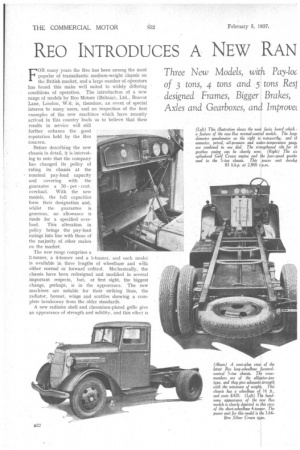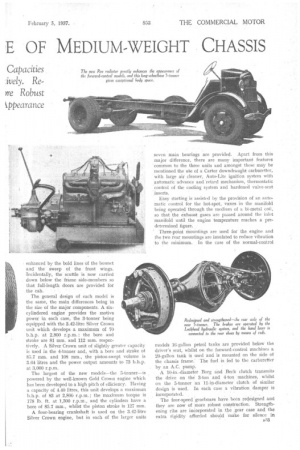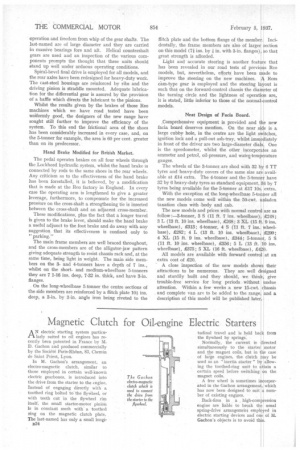REO INTRODUCES A NEW RAN E OF MEDIUM-WEIGHT CHASSIS
Page 46

Page 47

Page 48

If you've noticed an error in this article please click here to report it so we can fix it.
Three New Models, Iva Pay-lot of 3 tons, 4 tons and 5 tons Resj
designed. Frames, Bigger Brakes, Axles and Gearboxes, an Improve( Capacities .ively. Re we Robust ppearance
FOR many years the Reo has been among the most popular of transatlantic medium-weight chassis on the British.market, and a large number of operators has found this make well suited to widely differing conditions of operation. The introduction of a new range of models by Reo Motors (Britain), Ltd., Beavor Lane, London, W.6, is, therefore, an event of special interest to many users, and an inspection of the first examples of the new machines which have recently arrived in this country leads us to believe that their results in Service will still further enhance the good reputation held by the Reo Concern.
Before describing the new chassis in detail, it is. interesting to note that the company has changed its policy of rating its chassis at the nominal pay-load capacity and covering with the guarantee a 50 per cent overload. With the new models, the full capacities form their designation and, whilst the guarantee is generous, no. allowance is made for a specified overload. This alteration in policy brings the pay-load ratings into line with those of the majority of other makes on the market.
The new range comprises a 3-tonner, a 4-tormer and a 5-tonner, and each model is available in three lengths of wheelbase and with either normal or forward control. Mechanically, the chassis have been redesigned and modified in several important respects, but, at first sight, the biggest change, perhaps, is in the appearance. The new machines are notable for their striking lines, the radiator, bonnet, wings and scuttles showing a complete breakaway from the -older standards.
A new radiator shell and chromium-plated grille give an appearance of strength and solidity, and this effect is
enhanced by the bold lines of the bonnet and the sweep of the front wings. Incidentally, the scuttle is now carried down below the frame side-members so that full-length doors are provided for the cab.
The general design of each model is the same, the main differences being in the size of the major components. A sixcylindered engine provides the motive power in each case, the 3-tonner being equipped with the 3.42-litre Silver Crown unit which develops a maximum of 70 b.h.p. at 2,800 r.p.m. : the bore and stroke are 81 mill. and 112 ram. respectively. A Silver Crown unit of slightly greater capacity is used in the 4-tonner and, with a bore and stroke of 85.7 mm. and 108 mm., the piston-swept volume is 3.64 litres and the power output amounts to 73 b.h.p. at 3,000 r.p.m.
The largest of the new models—the 5-tonner—is powered by the well-known Gold Crown engine which has been developed to a high pitch of efficiency. Having a c:apacity of 4.40 litres, this unit develops a maximum b.h.p. of 83 at 2,800 r.p.m.; the 'maximum torque is 178 lb. ft. at 1,300 r.p.m., and the cylinders have a bore of 85.7 mm., whilst the piston stroke is 127 mm.
A four-bearing crankshaft is used on the 3.42-litre Silver Crown engine, but in each of the larger units
.seven main bearings are provided. Apart from this major difference, there are many important features 'common to the three units and amongst thee may be mentioned the ute of a Carter downdraught carburetter, with large air cleaner, Auto-Lite ignition system with .automatic advance and'retard mechanism, thermostatic control of the cooling system and hardened valve-seat inserts.
Easy starting is assisted by the provision of an automatic control for the hot-spot, vanes in the manifold -being operated through the medium of a bi-metal coil, so that the exhaust gases are passed around the inlet 'manifold until the engine temperature reaches a predetermined figure..
Three-point na-ountings are used for the. engine arid the two rear mountings are insulated to reduce vibration
• to the minimum. In the case of the normal-control
models 16-gallon petrol tanks are provided below the driver's seat, whilst on the forward-control machines a 20-gallon tank is used and is mounted on the side of the chassis frame.' The fuel is fed to the carburetter by an A.C. pump.
A 10-in.-diameter Borg and Beck clutch transmits the drive on the 3-ton and 4-ton machines, whilst on the 5-tonner an 11-in-diameter clutch of similar design is used. In each case a vibration damper is incorporated.
The four-speed 'gearboxes have been redesigned and they are now of more robust construction. Strengthening ribs are incorporated in the gear case and the extra rigidity afforded should make for silence in
operation and freedom from whip of the gear shafts. The last-named are of large diameter and they are carried in massive bearings fore and aft. Helical countershaft gears are used and an inspection of the various components prompts the thought that these units should stand up well under arduous operating conditions.
Spiral-bevel final drive is employed for all models, and the rear axles have been redesigned for heavy-duty work. The cast-steel housings are reinforced by ribs and the driving pinion is straddle mounted. Adequate lubrication for the differential gear is assured by the provision of a baffle which directs the lubricant to the pinions.
Whilst the results given by the brakes of those Reo machines which we have road tested have been uniformly good, the designers of the new range have sought still further to improve the efficiency of the system. To this end the frictional area of the shoes has been considerably increased in every case, and, on the 5-tonner for example, the area is 60 per cent. greater than on its predecessor.
Hand Brake Modified for British Market.
The pedal operates brakes on all four wheels through the Lockheed hydraulic system, whilst the hand brake is connected by rods to the same shoes in the rear wheels. Any criticism as to the effectiveness of the hand brake has been forestalled, it is believed, by a modification that is made at the Reo factory in England. In every case the operating arm is lengthened to give a greater leverage, furthermore, to compensate for the increased pressure on the cross-shaft a strengthening tie is inserted between the cross-shaft and an adjacent cross-member.
These modifications, plus the fact that a longer travel is given to the brake lever, should make the hand brake a useful adjunct to the foot brake and do away with any suggestion that its effectiveness is confined only to "parking."
The main frame members are well braced throughout, and the cross-members are of the alligator-jaw pattern giving adequate strength to resist chassis rack and, at the same time, being light in weight. The main side members on the 3and 4-tonners have a depth of 7 ins., whilst on the shortand medium-wheelbase 5-to/niers they are 7 1-16 ins. deep, 7-32 in. thick, and have 3-in. flanges.
On the long-wheelbase 5-tonner the centre sections of the side members are reinforced by a flitch plate 101 ins. deep, a 3-in. by 3-in, angle iron being riveted to the
flitch plate and the bottom flange of the membe Incidentally, the frame members are also of large section on this model (74 ins, by 4 in. with 3-in, flanges) so that great strength is afforded.
Light and accurate steering is another feat re that has been revealed in our road tests of previ us Reo models, but, nevertheless, efforts have been ade to improve the steering on the new machines. Ross cam-type gear is employed and the steering I yout is such that on the forward-control chassis the dia eter of the turning circle and the lightness of opera • on are, it is stated, little inferior to those of the norm control models.
Neat Design of Facia Board.
,Comprehensive equipment is provided and e new facia board deserves mention. On the near e is a large cubby hole, in the centre are the light s itches, ignition lock and a pull-out ash-tray, whilst imm diately in front of the driver are two large-diameter dia s. One is the speedometer, whilst the other incorpor tes an ammeter and petrol, oil-pressure, and watei-tem erature gauges.
The wheels of the 3-tonner are shod with 32 y 6 TT tyres and heavy-duty covers of the same size ar available at £14 extra. The 4-tonner and the 5-tonn r have 32 by 6 heavy-duty tyres as standard equipment, 34 by 7 tyres being available for the 5-tonner at £17 10s extra.
With the exception of the long-wheelbase 5-to er all the new models come well within the 50-cwt. niaden taxation class with .body and cab.
The new models and prices with normal cont ii are as follow :-3-tonner, 3 S (11 ft. 7 ins. wheelbase) 2248; 3 L (13 ft. 10 ins. wheelbase), £268; 3 XL (15 9 ins. wheelbase), £313; 4-toruaer, 4 S (11 ft. 7 ins. wheelbase), £282; 4 L (13 ft. 10 ins. wheelbase) £299; 4 XL (15 ft. 9 ins. wheelbase), 2344; 5-tonn r, 5 S (11 ft. 10 ins. wheelbase), 2356; 5 L (13 ft. 10 ins. wheelbase), £375; 5 XL (16 ft. wheelbase), 2 0.
All models are available with forward contr at an extra cost of £20.
A close inspection of the new models sho s their attractions to be numerous. They are well signed and sturdily built and they should, we thin , give trouble-free service for long periods without undue attention. Within a few weeks a new 15-cwt. chassis and complete van are to be added to the range and a description of this model will be published late




























































































